#Tableaux Vivants
Explore tagged Tumblr posts
Text
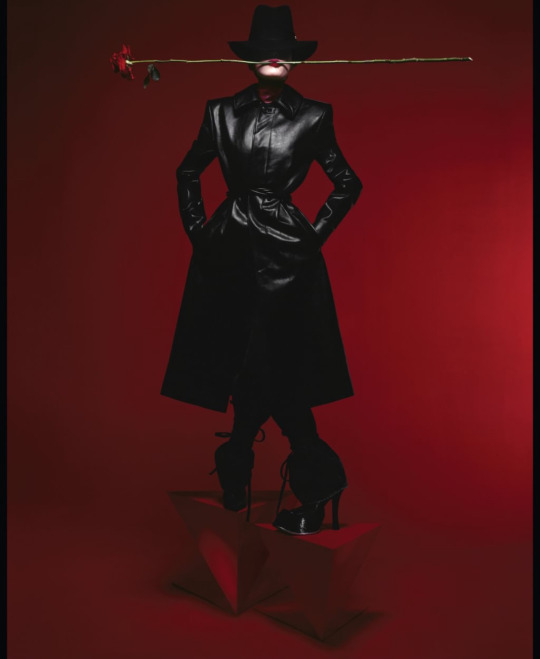
Coat, jeans, hat, and boots by McQueen. Neck scarf by Tableaux Vivants.
Photographed by Brigitte Niedermair. Styled by Patti Wilson. Modelled by Steinberg.
Elle September 2024
#mcqueen#alexander mcqueen#tableaux vivants#Brigitte Niedermair#Patti Wilson#Steinberg#elle magazine#fashion#luxury#glamour#ootd#follow#couture#haute couture#makeup#women's fashion#shopaholixs#fashion photography#photography
18 notes
·
View notes
Text


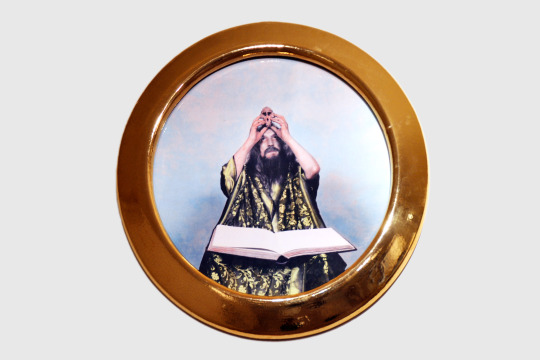
Tableaux Vivants (1969-1989) by Luigi Ontani
#Luigi Ontani#photography#performance#body art#italian photographer#Tableaux vivants#Tableaux vivant#'60s#'60s art#Dante#San Girolamo#Dante Alighieri#Frame#Golden#Art#kitsch#contemporary art#Saint Jerome#70s#'70s#Giuseppe Garibaldi
0 notes
Text

Night in a small town, New Mexico, Joel-Peter Witkin, 2007
#photography#art#joel-peter witkin#black and white#beauty and the grotesque#2000s#tableaux vivants#anthropomorphism#centaur
313 notes
·
View notes
Text
#peinture#peinture vivante#paint#painting#art#painting art#paint art#pintura#pittura#malerei#tableau#tableaux#peintre#artiste peintre#painter#vidéo#video#van gogh#vero emilie#vero emilie paint
194 notes
·
View notes
Text
Tableau vivant della compagnia Ludovica Rambelli Teatro
76 notes
·
View notes
Text
El arte de contar historias a través de "Cuadros vivos"…
Ryan Schude: el arte de contar historias a través de sus “Cuadros vivos”… Están los fotógrafos que saben capturar momentos, y luego está Ryan Schude, que transforma escenas en auténticos relatos visuales. Con su serie “Tableaux Vivants“, Schude crea fotografías que parecen detener una película en el tiempo, momentos llenos de personajes y situaciones que cuentan una historia – o mejor dicho,…
#2024#Artistas#EnPortada#Fotógrafos#Fotografía#fotografía cinematográfica#fotografía Tableaux Vivants#narrativa visual en fotografía#Ryan Schude director#Ryan Schude Tableaux Vivants
0 notes
Text
the chapter ACCOMPLISHMENTS from THE LADIES' BOOK OF ETIQUETTE, AND MANUAL OF POLITENESS Florence Hartley lists several skills and interests becoming for a young lady who is already well-educated. these accomplishments serve to impress others and delight oneself. she suggests to strive for the following ✧ conversing well, which is aided by a deep knowledge of literature ✧ music, played on an instrument and accompanied by singing (she explicitly recommends easier pieces for the less experienced in the company of others) ✧ drawing, sculpture and similar arts ✧ riding elegantly ✧ speaking french, german, and italian, as well as spanish ✧ dancing all fashionable dances ✧ reading out loud and reciting well ✧ arranging tableaux vivants ✧ crochet, knitting, tapestry work, embroidery, bead work, and many more
#nowadays a good movie could teach one to converse well too#and a good song selection when playing music from a phone or stereo is our selection of sheet music on the piano#she recommends books in foreign languages too - i'll compile them later#this chapter made me realise that i don't even know which dances are popular nowadays. i have to do some research#there's this suggestion to throw a dramatic literature reading party that sounds super fun#okay#i desperately need to learn to converse well#i play the clarinet and learning a few songs my friends and family should like will be fun and not too difficult#i also draw but not well or often enough. need to incorporate it into my weeks#and i know how to ride as well. seems like i have good chances to become a lady#my french is good but i'm not yet a big reader of french literature#however my german is native#i won't learn italian but i have been toying with the idea of learning latin so i'll pursue that in italian's stead#don't even ask about my dancing skills they're so bad. i'll see if any fashionable dance interests me or go to a club or something to figur#out if i'll even attempt dancing#i'll 100% improve my reading and reciting because it's so much fun to read out loud with friends#however i won't get into tableaux vivants and knitting will stay a winter hobby#that was the most interesting chapter so far!#accomplishment
1 note
·
View note
Text

Les Hautes Alpes, ce sont mes tableaux vivants.
Là où la montagne peint le silence,
où chaque sommet raconte le ciel.
Je regarde, je ressens
la nature crée, moi je contemple.
Lac de la Clarée / France 🇫🇷
PhoTo ©️LM
#nature#photographers on tumblr#nature photographer#original photography on tumblr#naturecore#france#original photographe#hautes alpes#savoie
281 notes
·
View notes
Text
I may wanna be gangbanged by men who call me a good girl for taking their cocks and cum, but I could never be a heterosexual because I don't know how to do makeup and I feel like girls putting makeup on eggy boyfriends (like a tableaux vivant recreation of the lesbians doing makeup meme) to queerbait the all seeing elf on the shelf is really the only reason for heterosexuality to exist.
61 notes
·
View notes
Text

Mary, Queen of Scots: The Farewell to France
Artist: Robert Herdman (Scottish, 1829 -1888)
Date: 1867
Medium: Oil on canvas
Collection: National Galleries of Scotland, Edinburgh, Scotland
Description
In 1867 the Glasgow Art Union commissioned Herdman to paint four pictures to illustrate episodes from of the life of Mary, Queen of Scots. The literary source for the pictures was the popular poem about Mary by the Glaswegian lawyer Henry Glassford Bell. In 1863 the Queen’s Theatre in Edinburgh had staged a series of tableaux vivants based on Bell’s poem. The success of these performances may well have prompted the Art Union’s commission to Herdman. This is the second picture in the set. It depicts the young Queen’s ill-fated return to Scotland in 1561 after the death of her first husband François II of France. In 1868, the entire set was offered as first prize to subscribers to the Union’s annual lottery.
#mary queen of scots#farewell to france#ship#seascape#painting#oil on canvas#history painting#historical art#fine art#oil painting#artwork#scottish culture#scottish art#women#man#sea#travel#journey#blanket#costume#ship sails#water#horizon#robert herdman#scottish painter#scottish history#scottish monarchy#scottish queen#european art#19th century painting
49 notes
·
View notes
Text
Like the petrifaction it is meant to inspire, the Gothic freezes its scenes into the tableaux vivants of eighteenth-century theater.
—The Gothic and the Art of Memory

#emily jane cohen#severance season 2#tableau vivant#18th century#theatre history#gothic terror#sublime#uncanny#mammalians nurturable#Lorne#baby goats#mark scout#helly r#gothic#severance#severance spoilers
38 notes
·
View notes
Text
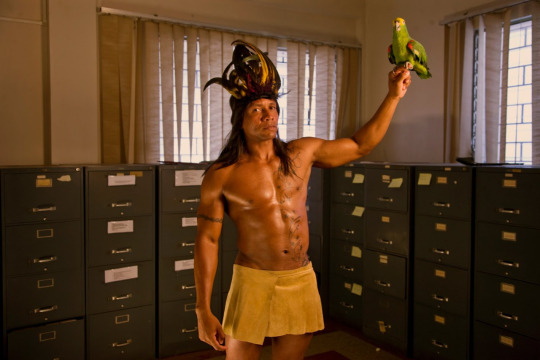
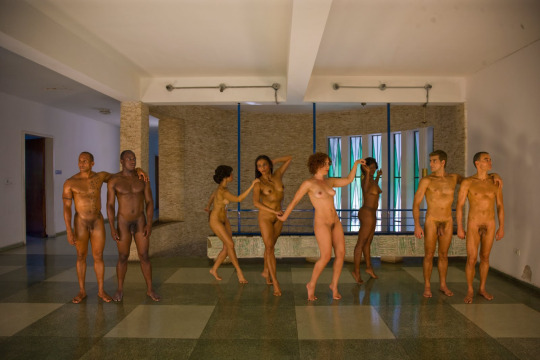
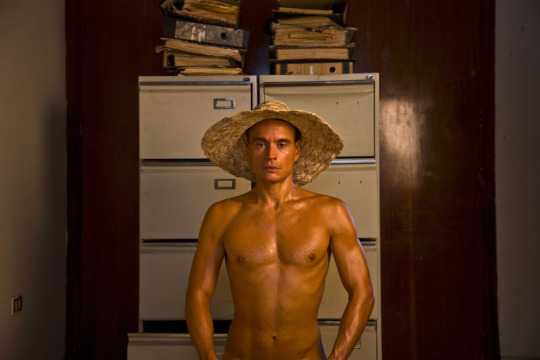


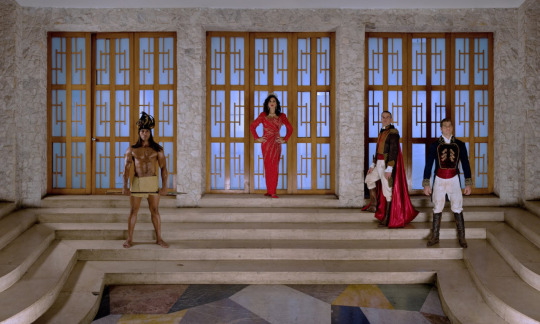
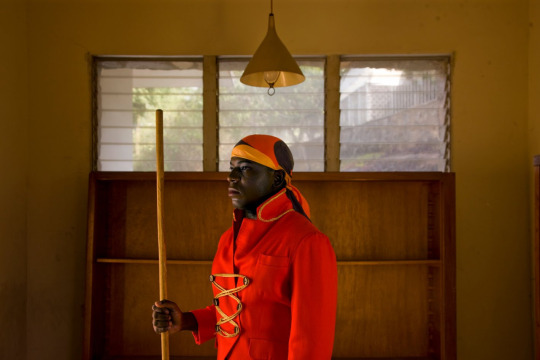
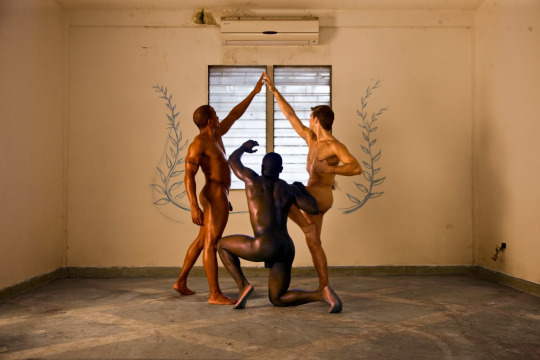
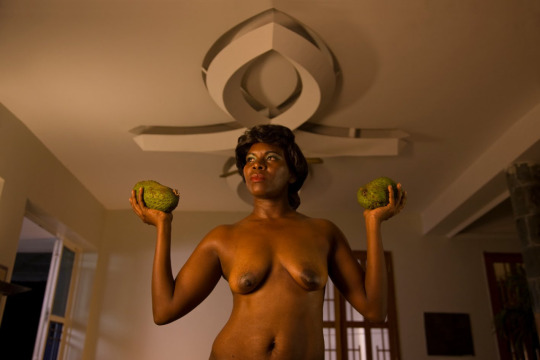
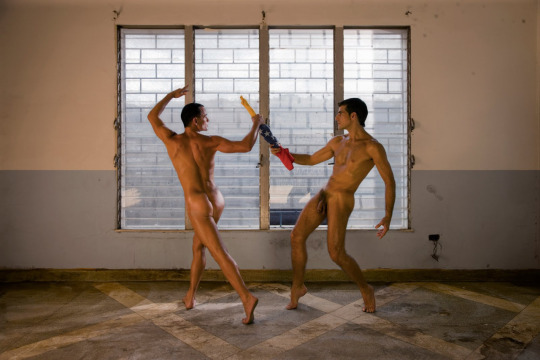
Ensayando la Postura Nacional by Alexander Apóstol
Based on the paintings of Pedro Centeno Vallenilla
Caracas experienced a strong urban construction growth after the death of the dictator Juan Vicente Gómez in 1936 until the 70´s. Important political changes: European and Latin-American migrations, and especially petroleum costs variations made Venezuelan mentality change at a speeding race to new perspectives that were demonstrated in different areas, architecture being the main element of change towards a modern city. Besides the big social differences, from then on, the Venezuelans have conceived to an extreme this modern period of time as the dream of a better future. In that time, important plastic artist irrupted during the 40´s, 50´s and 60´s; Escuela de caracas (landscaping), Los Disidentes (abstraction), and the Techo de La Ballena (informalism) were some of the most important avant-garde movements. Curiously enough, the Venezuelan artist Pedro Centeno Vallenilla, formed under the fascist Italian regime and exhibitor of a peculiar nationalist theme with a characterized mannerist and exaggerated aesthetic, worked independently from the avant-garde movements, he was even considered as a minor artist by them. Due to Vallenilla´s profound political views at the time, he was able to establish himself as the official painter during the dictatorship of Marcos Pérez Jiménez in the 50´s, where buildings like the National Capitol, the National Military or collections and private homes were decorated with his Works. Nowadays his works are still hung in these official buildings, where the nation’s history and the autochthonous elements together with the exaggerated and idealized aesthetic of the body and race, are the main characters in his work. What interests me is how his fertile visual language feeds the creation myths of the birth of the nation and establishes it like a part of the Venezuelan culture, in the political, social, military and even economic grounds of the country; where his work exemplifies, maybe fortunately, the prejudice, contradictions and acceptations on how Venezuelans want to see ourselves and how we wanted to be seen (and still want to be), contrasting with the exacerbated and vulnerable narcissism that fundaments itself on the starting resentments that we drag on form the colonial times. Finally I would like to focus Centeno Vallenilla´s work, independently from his pictorial quality, like the heir of a confused Venezuelan modernity in conception and ideology, confronted in the same way with the confused and complex political and social times that we are now living. Where the frontier between liberal ideologies and economic pragmatism associated with the conservatives, are faded together with the political ways of the country. In the film and photos, works of Centeno Vallenilla dedicated to the nation’s history, race and traditions, are converted into a tableaux vivant by people that come from the marginated areas of Caracas, but that are situated in the natural context of this artist, these spaces are modern but at the same time unused buildings, like a mansion turned into an office building; Nevertheless, these models try again and again, without achieving the goal, of recreating work by work The forced postures of the personalities represented in Vallenilla´s Works, demonstrating that there is a possibility that the idiosyncrasy of Venezuela comes from the eternal intent, with form but without meaning, of imagining improvised utopias that result in mere rehearsals of the country.
#art#paintings#photography#venezuela#pedro centeno vallenilla#venezuelan#alexander apóstol#venezuelan art
99 notes
·
View notes
Text
That Night The Cincinnati Zoo Became Venice And A Famed Artist Became A Lifeguard
It is largely forgotten now that the Cincinnati Zoo was originally organized as a for-profit enterprise. The stockholders soon realized that they needed to bring in more paying customers than exotic fauna could entice, and therefore musical concerts, summer dances, beer gardens and other non-zoological affairs soon peppered the Zoo schedule.
As the summer of 1880 wore on, Zoo visitors marveled at the construction underway around the central lagoon. Word got out that the Zoo had planned an extravaganza to exceed any of its previous entertainments and that the city’s finest artists had been recruited to bring this spectacular performance to life. Those artists were Henry Farny and Matt Morgan.
Farny, born in France, sketched for the local newspapers and executed a few theatrical posters before his excursions into the still very Wild West cemented his legacy as a premier painter of Native American life and culture.
Morgan, a Britisher, was lured to the United States by Frank Leslie’s Illustrated Weekly who needed a pen as talented and acerbic as that of Thomas Nast at the competing Harper’s Weekly. For much of the 1880s, Morgan was a leading artist at Cincinnati’s Strobridge Lithographing Company. He also staged “tableaux vivants” or “living pictures” at the Vine Street theaters, featuring nearly nude women posing in scenery reminiscent of classical paintings.
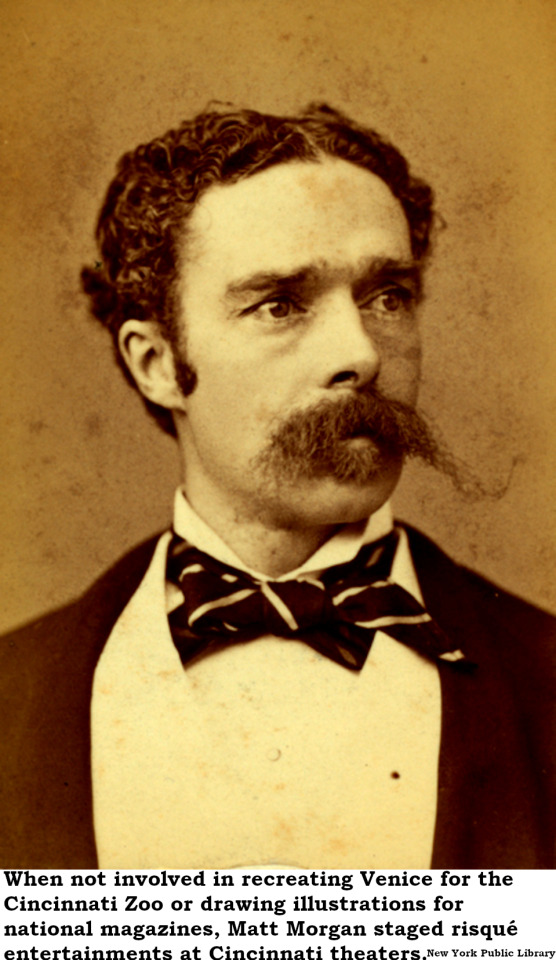
The Zoo seems to have entrusted Morgan and Farny with a substantial budget for their major production, to be titled “Visions of Venice.” The sets featured 40-foot replicas of the columns of San Marco and San Todaro, realistic façades of the Doge’s Palace, the Library of St. Mark, the Arsenal and other Venetian landmarks. The highlight of the presentation was to be a recreation of the traditional Sposalizio del Mare, the “Marriage of the Sea” ceremony, in which the Doge tosses a golden ring onto the waves to symbolize the entwined fates of the “Floating City” and the Adriatic Sea. The two artists succeeded in impressing the Cincinnati newspapers who attended the premiere. The Enquirer [24 August 1880] waxed rhapsodic:
“So much has been written in advance regarding this pageant, that but little other than the fact that the intentions of its design have been nearly realized remains to be told. The spectator is supposed to be seated on the place of St. Mark and all around him are the islands and canals of the Gem of the Adriatic. The effect is wonderfully realistic, and, to quote the words of one who lived long in the city of the Doges, ‘more beautiful by far than the original.’”
On opening night, the audience included many of Cincinnati’s leading citizens and their families. The Cincinnati Gazette [25 August 1880] identified Zoo founder Andrew Erkenbrecher, fur merchant A.E. Burkhardt, the McAlpin dry goods family, Times-Star publisher Charles Taft and others.
The evening began around 9:00 p.m. with a number of gayly decorated gondolas gliding into the Zoo’s lagoon, sporting colored lanterns at prow and stern, and carrying faux Venetians clad in elaborate Renaissance costumes. A serenade thrilled the crowd, though the Gazette confessed it was not exactly authentic in nature:
“In the middle, too, stood a minstrel, who sang to the accompaniment of a guitar. The moon was just rising over the roof of the Doge’s palace on the left and, as though apostrophizing it on the scene, he sang his song, ‘Wie Schoen Bist Du!’ – How beautiful art thou! The singer was Conrad Mueller, a German actor, and his Italian was very German; but his voice rang out high and clear and the effect was very beautiful.”
It was about this moment that the tableau was disrupted by a most amusing, if unscheduled, performance by the Venetian band. The Cincinnati Gazette recorded the ensuing debacle with undisguised relish:
“A fine orchestra had been engaged for the occasion and perched upon a platform built at the edge of the treacherous sea. While the musicians were waiting for the approach of a stately gondola the platform listed toward the water. A fat tuba player slipped over the side and fell into the Adriatic with a frightful splash. The ’cello player, who was related to him by marriage, plunged in to rescue him. This created a rush to the other side of the platform and, the whole thing giving way, the entire band was precipitated into the sea, instruments and all. The big fiddler jumped upon his fiddle and rode away to shore as majestically as though sealed in a pinnace. Not so easily did the others escape.”
The Cincinnati Commercial [24 August 1880] concurred that the impromptu orchestral bath was as entertaining as any of the intentional scenes arranged for the audience’s enjoyment:
“Fiddles and bows, horns and violincellos went flying through the air, and then gently floating on the receiving waves they danced there, but they made no music. That was furnished by the musicians sans instruments. They cried aloud and with a strong voice, ‘Save me, save me, I can not swim.’ It was Mr. Farny, who must be a most comfortable object for a drowning man to contemplate, who rescued these trusty musicians from their untimely fate.”
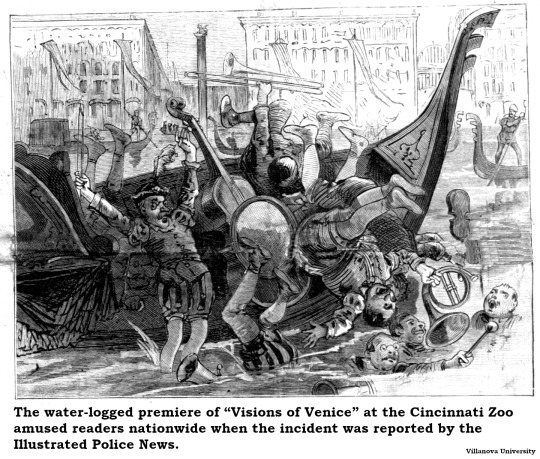
While Farny, the celebrated artist, was performing in his new and improvisatory role as a lifeguard, someone – this being Cincinnati, the City That Sings – managed to round up a completely new and completely dry orchestra and the ceremonial pageant resumed with only a slight delay.
The next event of the evening was billed as a jousting contest. The jousters were mounted on little platforms secured to the front of the gondolas. The young men of Cincinnati, although intimately familiar with horses, had little acquaintance with jousting outside Scott’s Waverly novels and put on a decidedly lackluster demonstration. According to the Enquirer:
“The first pair were very tame and afforded little sport. After they had ‘monkeyed’ around awhile and punched at each other much after the style of a washerwoman punching clothes in a boiler with a clothes-stick, they were allowed to retire, and a fresh pair took their places.”
Eventually, a proper joust was conducted, the Doge tossed a matrimonial ring into the Zoo lagoon, the Queen of Love and Beauty (a Main Street debutante) bestowed crowns upon a couple of ersatz knights, and the evening closed with a choral ensemble. Perhaps to encourage positive reviews, the Zoo restaurant picked up the tab for all the journalists in attendance that evening. “Visions of Venice” enjoyed a popular run over several weeks until the weather chilled.

8 notes
·
View notes
Text
I look through and read some historical books from time to time as i like to do, and its very educational and gives an overview of the time, but man are you suddenly jumped at with the historical aspect of things. all sorts of bigotry, or even just. off putting things from the time
like okay here's what im reading on this theater guide book from 1882 on using makeup to portray a jewish person on stage [from 'Theatricals and tableaux vivants for amateurs']


like oh my god. you should not be doing any of this. but it almost is commentating on the exaggeration and stereotyping that occured? and commenting that not all jewish people have hooked noses.
but man its always Something to just stumble upon these things. and of course, hasnt really changed, there was that recent scandal with the nose prosethtics in one film lmao
11 notes
·
View notes
Text

𝔦𝔩 𝔟𝔞𝔩𝔩𝔬 𝔡𝔢𝔩𝔩𝔞 𝔳𝔦𝔱𝔞
ambiance dark academia ;; the tortured poet department (the anthology)
forum city à Florence ;; groupes basés sur des tableaux célèbres de la Galerie des Offices
ℑ𝔫𝔰𝔭𝔦𝔯𝔞𝔱𝔦𝔬𝔫 𝔤𝔬𝔱𝔥𝔦𝔮𝔲𝔢 𝔯𝔬𝔪𝔞𝔫𝔱𝔦𝔮𝔲𝔢 ;; 𝔱𝔬𝔲𝔱 𝔱𝔶𝔭𝔢 𝔡𝔢 𝔭𝔢𝔯𝔰𝔬𝔫𝔫𝔞𝔤𝔢𝔰 𝔞𝔠𝔠𝔢𝔭𝔱𝔢́𝔰 ;; 𝔦𝔪𝔭𝔞𝔠𝔱 𝔧𝔢𝔲 𝔢𝔱 𝔥𝔦𝔰𝔱𝔬𝔦𝔯𝔢 𝔭𝔞𝔯 d𝔢𝔰 𝔠𝔞𝔯𝔱𝔢𝔰 𝔡𝔢 𝔱𝔞𝔯𝔬𝔱𝔰 (𝔭𝔢𝔯𝔰𝔬𝔫𝔫𝔦𝔣𝔦𝔠𝔞𝔱𝔦𝔬𝔫)
ℭ𝔬𝔫𝔱𝔢𝔵𝔱𝔢
Florence, écrin d’éternité où chaque pierre semble chuchoter les secrets d’un autre siècle, resplendit sous le crépuscule. Le fleuve Arno, d’un calme trompeur, serpente langoureusement entre les rives, tel un miroir d’une époque où l’art régnait en maître. Sur le Ponte Vecchio, des musiciens font sonner leurs mélodies dans l’air tiède, mêlant leurs notes aux murmures des amants et aux soupirs de passants éblouis. La nuit comme le jour, les êtres vagabondent dans l'espoir de se trouver, dans la passion ou l'horreur d'une simple décision. Dans une même âme peuvent cohabiter l’éclat de la bonté et l’ombre de la cruauté, tout comme la ville mêle sans effort la splendeur de son art à la mélancolie de son histoire. Ici, les artistes peignent la fièvre du vivant, les poètes murmurent à la Lune, et les passants, tour à tour monstres ou héros, tissent la toile complexe de l’humanité. Chaque rue devient une scène où le romantisme, l’art et les contradictions humaines s’entrelacent, dans une danse infinie qui n’appartient qu’à elle.
Rejoindre le discord du projet pour découvrir les groupes, et participer à la création du forum en donnant son avis, en construisant son personnage : https://discord.gg/7QFJMY3xfT
15 notes
·
View notes
Text
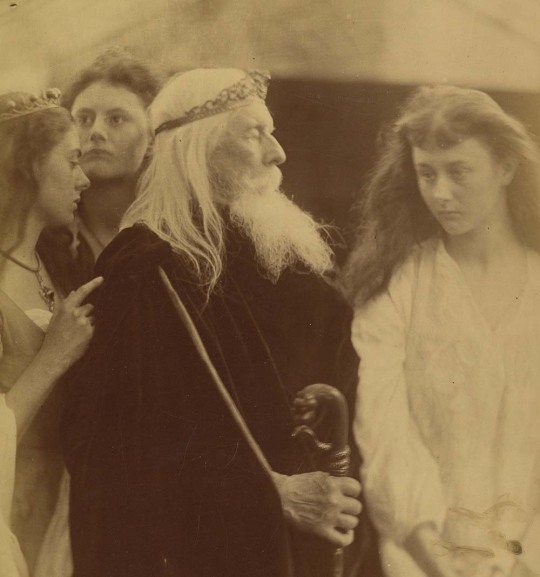
King Lear Alotting His Kingdom to His Three Daughters, by Julia Margaret Cameron, 1872. The Metropolitan Museum of Art, bequest of Maurice B. Sendak, 2012.
---
The Liddells never returned to be photographed by Carroll, but the sisters reappeared a decade later before Julia Cameron’s camera. Alice, Ina, and Edith posed for Cameron’s complicated tableaux vivants as Roman goddesses, literary heroines, and Shakespearean stories. In one photograph that typifies Cameron’s work, Alice and her sisters pose with her husband, Charles Hay Cameron, enacting a scene from King Lear. Charles plays the role of King Lear while the Liddells pose as his three ill-fated daughters, Ina’s index finger poignantly laid on his shoulder while Alice, hair down, fixes her gaze outside of the photograph’s frame, a look echoed by her younger sister Edith.
#shakespeare#william shakespeare#shakespeare on film#alice liddell#alice's adventures in wonderland#alice in wonderland#photograph#photogaphy#julia cameron#lear#kign lear#cordelia#goneril#reagan
125 notes
·
View notes